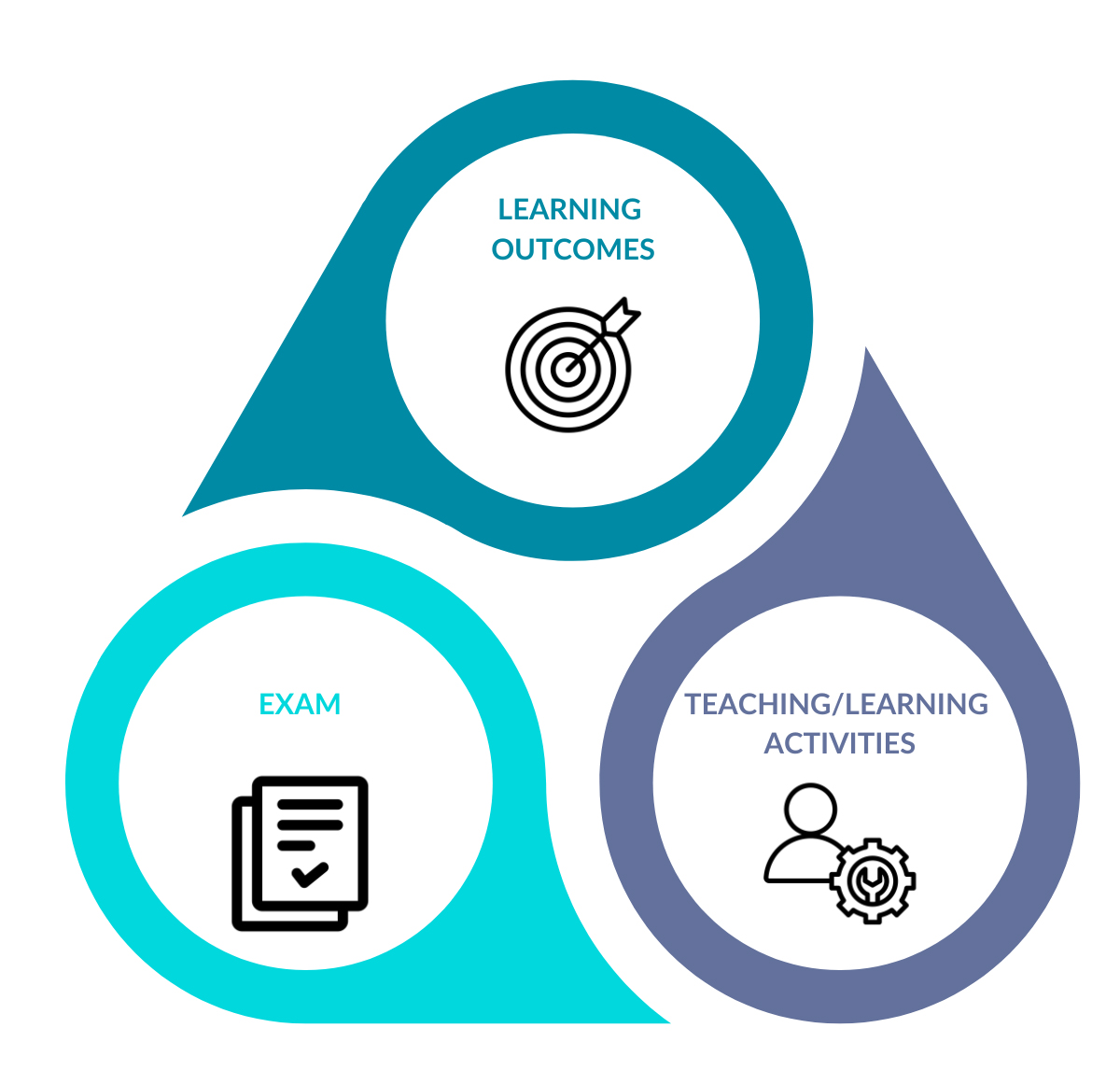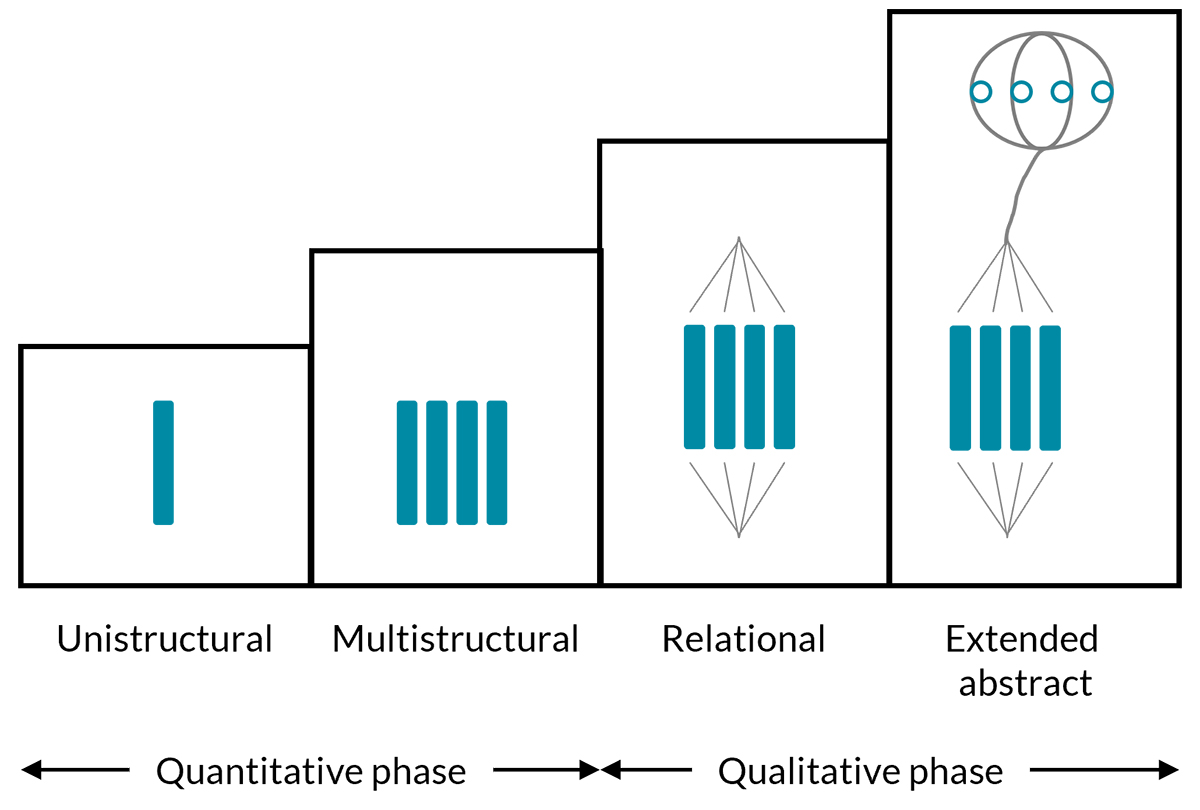Imagine the following situation: you are holding a course of lectures, carefully explaining all the terms and definitions and providing your students with learning material every week. Some students are always well prepared and have questions to ask when they come to the lectures. Others only seem to learn what is absolutely necessary. Why is that? And what can you do so that as many students as possible learn in depth? One approach is known as constructive alignment.
The example in the introduction is one that seems to be quite common in practice. Some students seem to take their own initiative and look into the subject matter intensively. They are active participants, ask questions and try to create connections between the different topics. Others pursue a superficial approach: they merely collect those building blocks of knowledge that are absolutely necessary to be able to pass the exam.
How you explain this fact largely depends on your understanding of teaching and learning. Here, Biggs & Tang (2011) differentiate between different levels:
Level 1: Focus on the students
Lecturers see learning success primarily as the result of the students’ individual characteristics. Good students apply in-depth learning strategies because they are motivated, intelligent and conscientious. Others, on the other hand, are not as successful because they do not have the required abilities or because they do not make enough effort. Biggs & Tang (2011) call this typical explanation “blame the student”.
Level 2: Focus on the lecturers
On this level, lecturers assume it is their responsibility to teach in such a way that all the students will produce the desired results in the end. Hence, failures are the result of flawed teaching behaviour. Lecturers subsequently try to improve lecture slides or enhance lectures with humour. This view is therefore also called “blame the teacher”.
Ebene 3: Fokus auf den Lernprozess der Studierenden
A third level focuses on the students’ learning process. From this point of view, designing a learning environment to foster suitable activities in students is a sign of quality in good teaching. It may be that students learn superficially because it has not been explicitly communicated to them what exactly is expected of them. Or it could also be due to the fact that they will achieve an extrinsic goal – passing an exam – even if they only deal with the learning material in a rudimentary fashion.
The solution: Constructive alignment
Biggs and Tang (2011) offer a solution that will foster the deep processing of learning content: constructive alignment. This term contains two aspects. The term constructive refers to a constructive view of learning. This approach is based on the assumption that terms, meanings, structures and action concepts cannot be transferred from lecturers to students as they would be with a “Nuremberg Funnel”. Instead, it is only through relevant learning activities that students construct knowledge. From this perspective, teaching is a catalyst for learning.
The principle of alignment means that learning outcomes, teaching and learning activities and exams are coherently aligned (see Figure 1).

Planning teaching at university according to constructive alignment is executed in three steps:
Step 1: Defining learning outcomes
Effective learning units are conceived of with the outcome as the starting point (Wiggins & McTighe, 2005). Therefore, the first task when planning learning units is to determine what students should know by the end. On no account does defining learning outcomes precisely mean that students cannot and should not achieve outcomes beyond that. Instead, you focus on the most important core competencies students should have by the end of a learning unit. The post “From knowledge to expertise: Define learning outcomes” provides tips to help you define learning outcomes for a wide range of academic competencies.
Step 2: Planning the exam
For the next step, determine how you and the students themselves can tell the learning outcome has been achieved. Here, the key thing is for students to get an idea of the competencies expected of them by already doing formative tests during the semester. That is the only way they themselves can establish the points they could and need to improve on and adapt their learning process accordingly.
In order for exams like this to be effective for learning, it is important for them to really test whether the learning outcomes have been achieved and to what extent. If one learning outcome is to connect up different theories but it is enough in the exam for students just to render facts, some students will presumably put in no more effort than to demonstrate that particular skill.
In traditional types of exams, the requirement for a stronger orientation towards competencies frequently conflicts with the manageability or economy of exams (Schaper, 2024). One solution could be a portfolio approach (Biggs & Tang, 2011), where students themselves choose which examples of their work illustrate their performance best. This approach enables different learning activities to come to the fore – not just those prescribed by lecturers.
Step 3: Selecting learning activities
To conclude, the teaching and learning activities are planned in a way that helps the students achieve these objectives. Student activities like listening and thinking for themselves are very suitable for understanding terminology or gaining an initial idea of the different connections. Active forms of learning like discussions, group work or project work can inspire learners to think about the material in more depth and apply it.
Regardless of teaching format, effective teachers confront their students with key problems and authentic tasks that challenge them to deal with ideas, reconsider their assumptions and review their mental model of reality (Bain, 2004). Illustrating the relevance of the subject matter to you as a lecturer or demonstrating practical fields of application are also two of the many other ways to succeed in motivating students to deal with the subject matter in more depth. Sometimes motivation is not just a requirement, it is also the result of learning processes.
Constructive Alignment in practice
It is not always easy to implement these three steps in practice due to the following aspects: What teaching methods are suitable for achieving specific learning outcomes? How can exams be prepared in traditional systems as well so that they test the learning outcomes in a way that is as valid as possible? On his website, Atkinson (2022) offers good reference points for the teaching methods and exam types that are suitable for achieving learning outcomes at different skill levels at universities.
AI can help
When it is a question of fostering and testing cognitive processes of comprehension, artificial intelligence can also be helpful.
In practice, one objective that is frequently formulated is for students to understand certain contents. What initially sounds banal and something that goes without saying holds a key question in higher education: how can you discern whether the subject matter in question has been understood? The answer will presumably vary depending on the degree of expertise of the person asked. To make the term “understand” more comprehensible for teaching purposes, Biggs and Collins (1982) use the SOLO taxonomy (Structure of the Observed Learning Outcome) to differentiate between different depths of understanding.

At level 1 (uni-structural), learners concentrate on one individual aspect of the task or topic. They can name a fact or describe an individual concept without linking it up to a bigger picture. At the next level (multi-structural), learners identify several relevant aspects of the topic, but largely see these as independent and unconnected units. Starting from the third, relational level, knowledge changes not only quantitatively but also qualitatively. Learners discern how different aspects of the topic are connected to each other and are then able to put them into a context. It is not until the last level (extended abstract) that learners are able to generalise knowledge gained and transfer what they have learned to unfamiliar situations, develop hypotheses and formulate abstract principles.
With the help of the PPT to SOLO Taxonomy Tasks application, lecturers can create tasks for all competency levels in the SOLO taxonomy in just a few clicks.
Just upload a file that fits the topic (e.g. slides from a lecture) and enter a simple prompt, such as “Create test questions for the uploaded slides”. The application will deliver suitable tasks in seconds. You can provide these as exercises for self-learning phases, for example, or use them as stimuli for activations or discussions in in-person lectures or seminars.
With the additional prompt “Write detailed criteria for the tasks that can be used to evaluate the answers”, for example, you convert the tasks into formative or summative exam questions. The evaluation criteria that are also provided make marking significantly easier.
Even though tools like this are extremely helpful, a clear research basis linking teaching and learning activities directly to specific learning outcomes is still largely lacking. What is more important than the choice of a particular teaching method is how well the method selected is applied (Renkl, 2015). In practice, this is often a question of the lecturer’s experience and discernment. An ongoing evaluation of the learning processes (e.g. with the Teaching Analysis Poll) or intense reflection on your own teaching behaviour help you to understand and foster the students’ learning processes specific to the context.
References
Atkinson, S.P. (2022). Writing Good Learning Outcomes and Objectives. Sijen Education.
Bain, K. (2004). What the best college teachers do. Harvard University Press.
Biggs, J., & Tang, C. (2011). Teaching For Quality Learning At University. McGraw-Hill Education.
Renkl, A. (2015). Drei Dogmen guten Lernens und Lehrens: Warum sie falsch sind. Psychologische Rundschau, 66(4), 211–220. https://doi.org/10.1026/0033-3042/a000274
Schaper, N. (2021). Prüfen in der Hochschullehre. In R. Kordts-Freudinger, N. Schaper, A. Scholkmann, & B. Szczyrba, Handbuch Hochschuldidaktik. (S. 87 – 101). UTB.
Wiggins, G. P., & McTighe, J. (2005). Understanding by design. ASCD.
Suggestion for citation of this blog post
Hawelka, B. (2024, November 14). Constructive Alignment. Lehrblick – ZHW Uni Regensburg. https://doi.org/10.5283/ZHW.20241115.EN

Birgit Hawelka
Dr. Birgit Hawelka is a research associate at the center for University and Academic Teaching at the University of Regensburg. Her research and teaching focuses on the topics of teaching quality and evaluation. She is also curious about all developments and findings in the field of university teaching.





